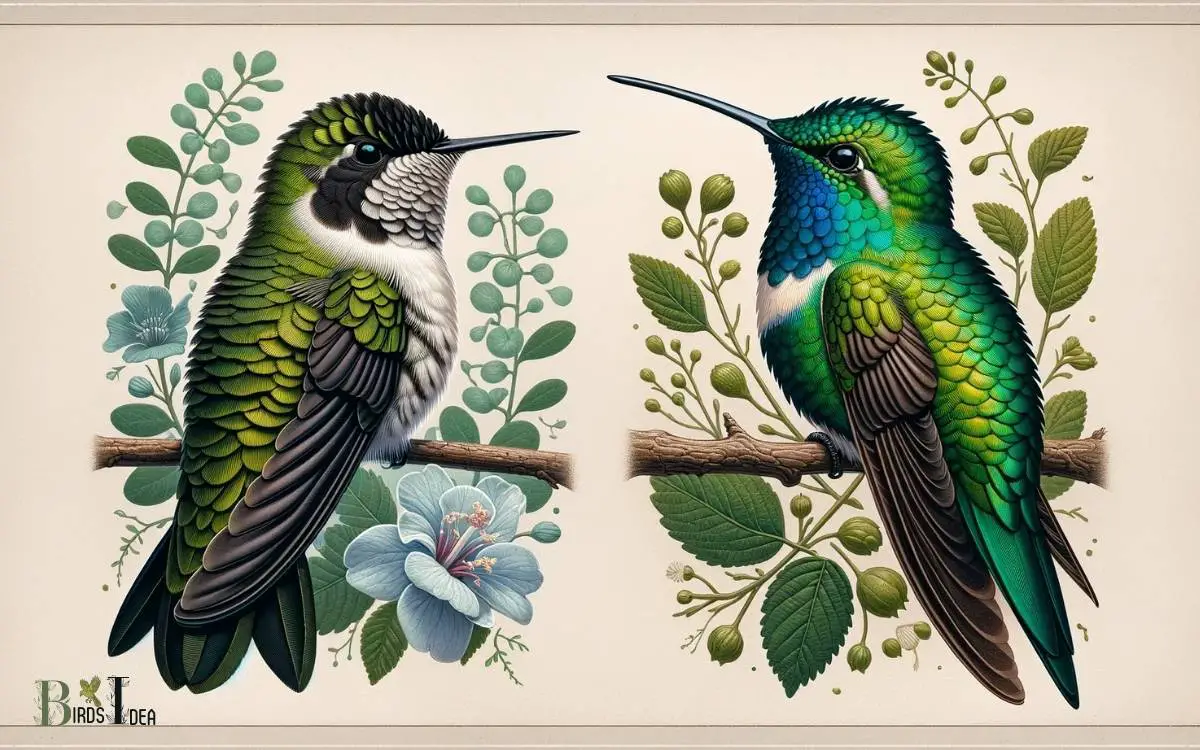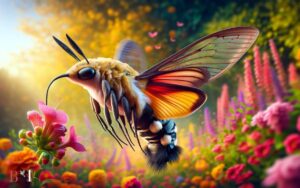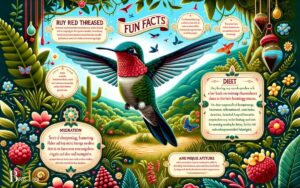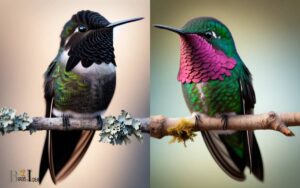Bumblebee Hummingbird Vs Bee Hummingbird: Comparison!
The Bumblebee Hummingbird and the Bee Hummingbird may sound similar, but they are distinct species with unique characteristics.
The Bumblebee Hummingbird (Atthis heloisa) primarily inhabits Mexico, known for its vibrant green plumage and compact size.
Conversely, the Bee Hummingbird (Mellisuga helenae) claims the title of the world’s smallest bird and is endemic to Cuba, featuring iridescent feathers with males showcasing brilliant red throats during the breeding season.
When differentiating these two species, several factors come into play:
Distinct in their beauty, the Bumblebee and Bee Hummingbirds captivate bird enthusiasts with their dazzling colors and diminutive statures, each species offering a glimpse

Key Takeaway
Physical Characteristics
The physical characteristics of the Bumblebee Hummingbird and Bee Hummingbird differ in size and coloration.
The Bumblebee Hummingbird (Atthis heloisa) is slightly larger, measuring around 3 inches in length and weighing approximately 2.0-2.4 grams.
Its plumage exhibits a mix of vibrant green, rufous, and sometimes blue hues on the upperparts, with a whitish or rufous belly.
In contrast, the Bee Hummingbird (Mellisuga helenae) is the smallest bird species, averaging only 2 inches in length and weighing about 1.6-2.0 grams.
Its feathers showcase iridescent green and fiery red tones, especially in males, while the females have more subdued coloration.
These distinct physical features are reflective of their respective species and play a crucial role in their survival and behavior.
As we delve into their habitat and range, it becomes evident how these physical characteristics are adapted to their specific environments.
Habitat and Range
The geographic distribution of the Bumblebee Hummingbird and Bee Hummingbird varies significantly, with the former found in parts of Mexico and Central America, while the latter is restricted to the island of Cuba.
Additionally, their unique nesting habits contribute to their differing habitats, with the Bumblebee Hummingbird often nesting in coniferous forests and the Bee Hummingbird favoring mangrove swamps and lowland forests.
Understanding these distinctions in habitat and range sheds light on the ecological adaptations of these two remarkable species.
Geographic Distribution Differences
Geographic distribution differences in habitat and range between the bumblebee hummingbird and bee hummingbird are significant factors in understanding their ecological niches and evolutionary adaptations.
Bumblebee Hummingbird (Atthis heloisa):
- Found in Mexico and parts of Central America.
- Inhabits montane forests, pine-oak woodlands, and tropical scrublands.
- Prefers higher elevations ranging from 1,000 to 3,000 meters.
- Feeds on nectar from a variety of flowering plants.
- Nests in sheltered locations such as tree branches or shrubs.
Bee Hummingbird (Mellisuga helenae):
- Endemic to Cuba and the Isla de la Juventud.
- Inhabits a range of habitats including forests, coastal areas, and gardens.
- Found at lower elevations, typically below 600 meters.
- Feeds on nectar from a diverse array of flowering plants.
- Nests in small, cup-shaped nests secured to tree branches.
Understanding these geographic distribution differences sheds light on the specialized adaptations of each species to their specific habitats.
Unique Nesting Habitats
Distinguished by their unique nesting habitats, the bumblebee hummingbird and bee hummingbird demonstrate specialized adaptations to their respective environments.
The bumblebee hummingbird, found in Mexico and Central America, typically nests in forests, choosing sheltered locations such as the forked branches of trees or shrubs.
In contrast, the bee hummingbird, native to Cuba and the Isle of Youth, often builds its nest in more varied locations, including tiny, cup-shaped structures in the branches of trees or shrubs, and occasionally in human-made structures like clotheslines.
These distinct nesting behaviors reflect the specific environmental conditions and resource availability in their respective ranges.
Understanding these nesting habits provides insight into the evolutionary strategies developed by these diminutive birds to thrive in their unique habitats.
This understanding of nesting behaviors naturally leads to an exploration of their feeding behavior.
Feeding Behavior
The feeding behavior of the Bumblebee Hummingbird and the Bee Hummingbird is a fascinating subject that encompasses their nectar preferences and foraging techniques.
Understanding the specific types of flowers and nectar sources preferred by each species provides valuable insights into their ecological niche and potential competition.
Furthermore, comparing their foraging techniques sheds light on the evolutionary adaptations that have enabled these tiny birds to thrive in their respective habitats.
Nectar Preferences
During the breeding season, bumblebee hummingbirds and bee hummingbirds exhibit distinct nectar preferences, reflecting their specialized feeding behaviors.
Bumblebee Hummingbird:
- Prefers nectar from larger, more robust flowers.
- Has a longer bill, allowing access to deeper flower corollas.
- Feeds on a variety of flower types, including Heliconia and Fuchsia.
- Consumes nectar with lower sugar concentrations due to its larger size and higher energy expenditure.
- Shows a preference for red and orange flowers.
Bee Hummingbird:
- Favors nectar from smaller, more delicate blooms.
- Possesses a shorter bill, suited for shallower flowers.
- Primarily feeds on tubular flowers such as Hamelia patens and mistletoe.
- Consumes nectar with higher sugar concentrations due to its smaller size and higher metabolic rate.
- Displays a penchant for white and pink flowers.
Foraging Techniques
Both bumblebee hummingbirds and bee hummingbirds employ distinct foraging techniques to efficiently obtain nectar from their preferred flowers.
Bumblebee hummingbirds, despite their larger size, exhibit remarkable agility, hovering adeptly near flowers while feeding.
Their foraging behavior involves visiting a diverse array of floral species, often favoring those with tubular or bell-shaped corollas. In contrast, the diminutive bee hummingbird utilizes its specialized bill to access nectar from small, delicate flowers.
This species is known for its precision flight patterns, enabling it to swiftly move between blossoms while feeding.
Both species play a crucial role in pollination, with bumblebee hummingbirds contributing to the pollination of medium-sized flowers, while bee hummingbirds are particularly effective at pollinating small, specialized blooms.
These foraging techniques are essential to their survival and contribute significantly to the ecosystems they inhabit.
Breeding and Nesting
Breeding and nesting, essential for the survival of hummingbirds, is characterized by intricate courtship displays and the construction of elaborate nests.
Hummingbirds are known for their unique breeding behaviors, which differ slightly between the Bumblebee Hummingbird and the Bee Hummingbird.
These tiny birds usually mate in the spring and summer months, with males performing dazzling aerial displays to attract females.
Once a female selects a mate, she constructs a small cup-shaped nest using materials like moss, lichen, and spider silk, camouflaging it with the surrounding environment. The female then lays 1-3 pea-sized eggs, which she incubates for about 2 weeks.
After hatching, the chicks are fed a diet of regurgitated nectar and insects until they fledge. This intricate process ensures the continuation of these remarkable avian species.
Conservation Status
The conservation status of the Bumblebee Hummingbird and the Bee Hummingbird differs, with the former being categorized as Near Threatened and the latter as Least Concern by the International Union for Conservation of Nature (IUCN).
This variation in status reflects the differing levels of threat each species faces in their natural habitats.
The Bumblebee Hummingbird is facing habitat loss and degradation, primarily due to deforestation and urbanization, leading to its classification as Near Threatened.
Conversely, the Bee Hummingbird, although not immune to habitat loss, is more adaptable and widespread, resulting in its current classification as Least Concern.
| Species | Conservation Status |
|---|---|
| Bumblebee Hummingbird | Near Threatened |
| Bee Hummingbird | Least Concern |
Interesting Facts
Discussing the interesting facts about the Bumblebee Hummingbird and the Bee Hummingbird reveals their unique foraging behaviors. These tiny creatures, both measuring around 2 inches in length, exhibit remarkable characteristics.
- Territorial Nature: Both species are highly territorial and fiercely defend their feeding areas from intruders.
- High Metabolism: Bumblebee Hummingbirds have the highest metabolism of any bird, requiring them to feed almost constantly to sustain their energy levels.
- Unique Flight Patterns: Bee Hummingbirds are known for their remarkable aerial acrobatics, including flying backward and even upside down.
- Distinctive Nests: Bumblebee Hummingbirds construct their nests using lichens, mosses, and plant fibers, camouflaging them with spider silk to blend into their surroundings.
- Specialized Diets: Bee Hummingbirds have a specialized diet, often feeding on tiny insects in addition to nectar, making them the only known hummingbird species to regularly include insects in their diet.
Conclusion
The bumblebee hummingbird and bee hummingbird both possess remarkable physical characteristics and exhibit fascinating feeding behavior. Their unique habitats and nesting habits contribute to their conservation status.
These tiny creatures, with their iridescent feathers and swift movements, are like delicate jewels flitting through the air, bringing life and beauty to the ecosystems in which they thrive.
It is important to continue efforts to protect and preserve these extraordinary birds for future generations to appreciate.






